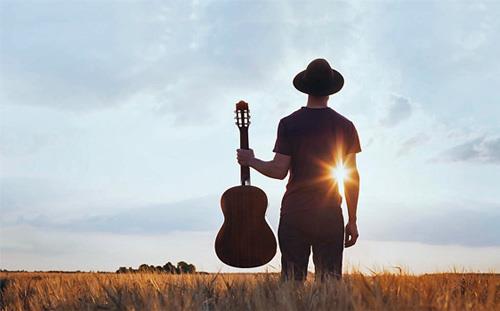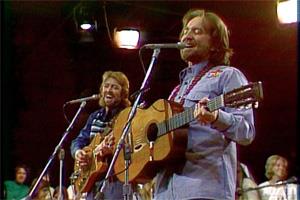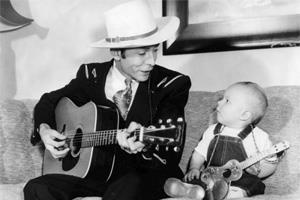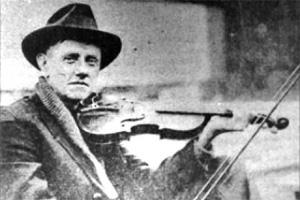
If you imagine that Ken Burns' new PBS epic on country music would revolve around a bunch of grinning white guys wearing cowboy hats, you haven't been paying attention.
To the history of country music.
Or to the history of Ken Burns.
Country Music, a 16-hour production that launches Sunday at 8 p.m. ET on PBS and will air over eight nights (check local listings), isn't the first musical rodeo for Burns. He previously did a series on jazz, and music has played a central role in every one of his productions, from The Civil War to The Vietnam War.
As Burns tells it, music both reflects and helps shape the culture and sociology of American events and times. So when he gets to country music, he doesn't just bring out the fiddle and the steel guitar. He wants to explain how they got here, why they got here, and what it all means.
Right upfront, it means that country music isn't just white folks' music. It's American music, a rich gumbo bubbling not just with Irish and Scottish ballads, but with African rhythms, black and white gospel anthems, Cajun dance tunes, Mexican and Tejano melodies and a splash of every popular musical notion that has coursed through the land, from Stephen Foster to Tin Pan Alley and zany novelty numbers. "I’m My Own Grandpa," anybody?
From the first minutes of the first episode, director Burns and writer Dayton Duncan make it clear they see "country" as an inclusive adjective.
 They explain the Carter Family, Bob Wills, Hank Williams, Loretta Lynn, Patsy Cline, Willie Nelson (right), Merle Haggard, and Garth Brooks as artists playing the music of America. "Lovesick Blues" and "Will the Circle Be Unbroken" aren’t speaking only to rednecks waving shotguns out of the windows of their pickup trucks while they pop the top on another Lone Star.
They explain the Carter Family, Bob Wills, Hank Williams, Loretta Lynn, Patsy Cline, Willie Nelson (right), Merle Haggard, and Garth Brooks as artists playing the music of America. "Lovesick Blues" and "Will the Circle Be Unbroken" aren’t speaking only to rednecks waving shotguns out of the windows of their pickup trucks while they pop the top on another Lone Star.
Now it's true, and Country Music acknowledges, that country artists and audiences have been and remain overwhelmingly Caucasian.
But the music itself flows from multiple tributaries, something acknowledged by artists here as a simple matter of fact.
The two hours of the opening episode track, in detail, how the original country music drew on blackface minstrel show music, the black string bands that flourished a century ago, and the hymns of the black churches, right alongside the fiddle and dance tunes from the mountains of Appalachia and tragic folk ballads like "Barbara Allen."
This is equally true: Because it first took root in the rigidly segregated South, country music was primarily played and marketed on one side of the tracks, just as blues and jazz music were primarily played and marketed on the other.
But Country Music stresses how easily and often the music itself floated across those tracks, making it one of the few cultural areas in which segregation not only would have been impossible to enforce but would have been unpopular.
White folks who considered themselves superior to black folks, and let's not forget that described much of white America a century ago, still often enjoyed the music made by those musicians of color.
 Down the road, this musical affinity would constitute a crucial wedge in the long campaign to break down segregation's doors. But that's a topic for and from other Burns productions. Country Music focuses on reminding everyone how much black music has infused the sound of country artists, from Jimmie Rodgers to Bob Wills, Hank Williams (left, with Hank Jr.), Merle Haggard, and beyond.
Down the road, this musical affinity would constitute a crucial wedge in the long campaign to break down segregation's doors. But that's a topic for and from other Burns productions. Country Music focuses on reminding everyone how much black music has infused the sound of country artists, from Jimmie Rodgers to Bob Wills, Hank Williams (left, with Hank Jr.), Merle Haggard, and beyond.
With that established, the series moves into more sociology, like the voice the music gave to victims of the Great Depression and the impact of so many country musicians joining the military during World War II. It covers the music revolution of the post-war years, the prolonged suppression and eventual rise of female artists, the gradual drift away from steel guitars and fiddles, and the personal bond so many fans feel with artists.
Along the way, it provides gratifying amounts of the music itself, though alas, almost nothing was filmed in the pre-Depression era.
Much of the later film, perhaps most strikingly in the low-budget TV shows of the 1950s and 1960s, offers a fascinating contrast between wonderful songs and hopelessly lowbrow packaging.
From the earliest days, when "hillbilly" records were a long-shot afterthought for the fledgling industry, it was considered smart business to package the performers as hillbillies themselves, or maybe as cowboys, with stage outfits to match.
Many of the performers, particularly the professional musicians, didn't care for this vaudevillian getup. But marketing won out, a victory underscored as late as the 1960s-'70s TV show Hee Haw. Welcome to show biz.
As with past Burns productions, the amount of time he devotes to sociology clearly forces some choices in other areas, in this case, how much of which aspects of the music itself he can feature.
On opening night, for example, we get an extensive segment on DeFord Bailey, a black harmonica player who was a fixture in the early days of the critical Grand Ole Opry radio show.
 We also get extended segments on three of the most important seminal figures of the 1920s, Fiddlin' John Carson (left), the Carter Family, and Jimmie Rodgers.
We also get extended segments on three of the most important seminal figures of the 1920s, Fiddlin' John Carson (left), the Carter Family, and Jimmie Rodgers.
All fine, all fully justified. It just means we have time for almost nothing on the popular and important string bands who also shaped the country music of the 1920s, like Charlie Poole & The North Carolina Ramblers, Gid Tanner & His Skillet Lickers, Darby & Tarlton, the Georgia Yellow Hammers or the Red Fox Chasers.
The narrative, nicely voiced by Peter Coyote, tells the story cleanly, and only occasionally gets a little carried away. Saying country music tells the truth and reflects the lives of its listeners is a sweet compliment, except that's true of virtually all popular music.
Whatever the debates about what's put in or left out – and we can be sure Burns and his team had those debates, too – Country Music delivers a literate, informed, detailed history of a major part of American popular culture.
And, just as with other parts of American popular culture, we too often forget, or don't consider it important. Burns reminds us it is, in an entertaining way that also reminds us why.